Your home isn’t just a place to crash—it’s a tool that can nudge you toward your wellness goals. The air you breathe, the furniture you pick, even the way you arrange things, all of it shapes your physical and mental health.
Remember to repin your favorite images!
When you create a wellness-driven home, you’re making your space work for your health priorities. It’s a lot easier to stick with healthy habits when your surroundings back you up.
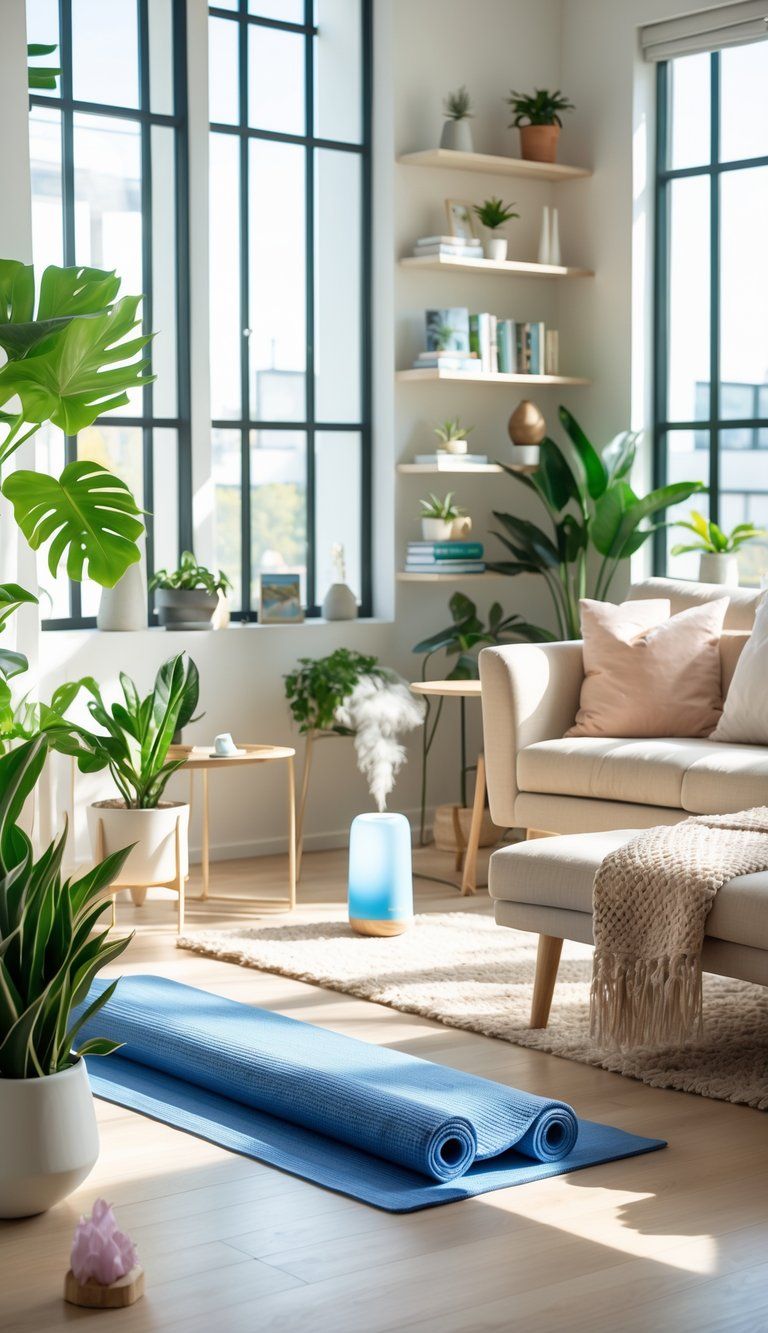
Take a moment and ask yourself: does your home make your wellness routines easier or harder? Is your kitchen set up for healthy cooking? And how about your bedroom—does it help you get good sleep?
Small tweaks can really change how you feel day to day.
The best wellness homes mix smart design with healthy routines. Clean air, sunlight, comfy furniture, and organized spaces all work together to lower stress and boost your energy.
When your environment supports you, making healthy choices just feels more natural.
Understanding the Connection Between Home and Wellness
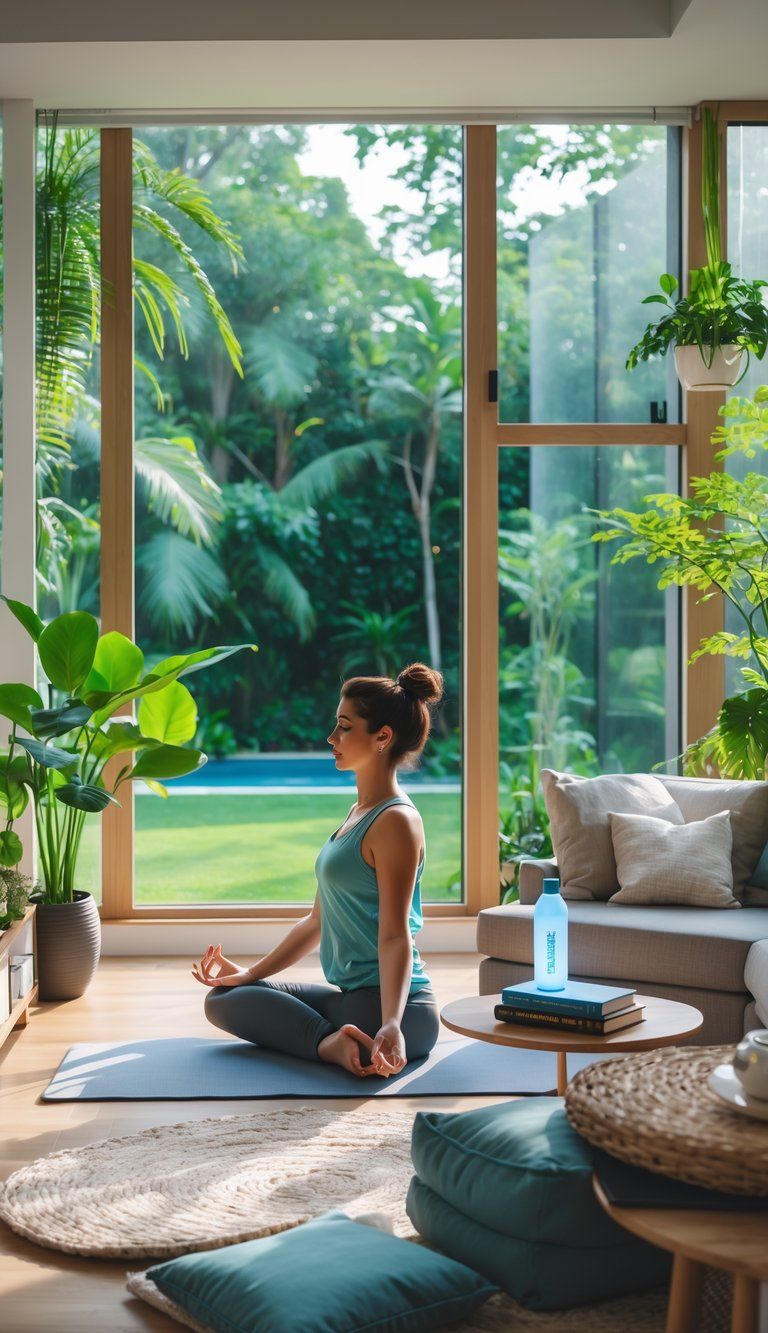
Your home isn’t just walls and a roof—it’s a whole environment that shapes how you feel and function. The places where you eat, sleep, or chill out can either lift you up or drag you down.
The Impact of Home Environment on Mental and Physical Health
Your surroundings have a bigger impact on your health than you might think. Cluttered rooms can crank up your stress and make it tough to focus.
Researchers have found that people in messy homes often have higher cortisol levels. That’s the stress hormone, by the way.
Natural light matters too. If you get good daylight in your rooms, it helps balance your sleep and mood.
Try putting your desk by a window, or if you don’t have much sunlight, go for full-spectrum lights.
Air quality is another biggie. Indoor air can be way more polluted than what’s outside.
Add a few air-cleaning plants like snake plants or spider plants. They’ll boost oxygen and help clear out toxins.
Noise in your home can mess with your stress and sleep. Rugs, curtains, and cushy furniture soak up sound and make things feel calmer.
How Your Mindset Shapes Your Living Space
Your beliefs and attitudes influence how you set up your home. If you care about wellness, you’ll naturally create spaces that help you stick to healthy habits.
Start by figuring out what matters most for your own wellness. Do you want a workout corner? Or maybe a quiet reading spot? Maybe a clutter-free kitchen makes healthy eating easier for you.
Let your answers guide your design.
Be picky about what you bring into your space. Before you buy something, ask yourself, “Does this help my wellness goals?” That simple question can save you from collecting stuff you don’t need.
Your emotional connection to home counts, too. Fill your space with things that make you smile or remind you of good times.
Try displaying a few photos or objects that really mean something to you.
Set up little rituals in certain spots. Maybe a meditation corner or just a favorite chair for your morning coffee—it’s these small things that make a difference.
Decluttering and Organization for Mental Clarity

A tidy, organized home isn’t just about looks—it genuinely helps your mental wellbeing. You’ll find it easier to focus and feel calm when your space isn’t a mess.
Why Decluttering Reduces Stress
Clutter messes with your brain more than you might realize. When your stuff is all over the place, your mind gets pulled in a million directions.
That mess creates mental fatigue and ramps up stress. Studies have shown that people living with clutter have higher stress hormones, especially cortisol.
Decluttering can actually feel good. Going through your things and deciding what to keep helps you practice mindfulness and sharpens your decision-making.
Plenty of people say they feel lighter and more in control after clearing out their space. That little boost can spill over into other areas of your life.
When you’re unsure about an item, try asking, “Does this spark joy?” It’s simple, but surprisingly effective.
Effective Organization Strategies
Don’t try to organize your whole place in one go. Pick one small area, like a drawer or a closet, and finish it before moving on.
Here are some practical systems that actually work:
- Zone-based organization: Keep similar items together.
- Container method: Only keep what fits in your bins or baskets.
- One-in-one-out rule: For every new thing you bring in, let something old go.
Some handy storage solutions include:
- Clear bins so you can see what’s inside
- Wall shelves to free up floor space
- Under-bed boxes for stuff you only use sometimes
- Door organizers for those little odds and ends
Label things. Seriously, it saves so much mental energy. If you’ve got kids or roommates, color-coding can help everyone stay on track.
Maintaining a Clutter-Free Home
Staying organized is all about the little habits. Instead of giant cleaning days, work small daily tasks into your routine.
Try the “2-minute rule”—if something takes less than two minutes, just do it now. Hang up your coat, file a paper, wash that mug.
Set up systems that match your habits. If you always drop your mail on the kitchen counter, put a basket there for sorting instead of fighting it.
Don’t forget your digital life. Clean out your inbox, desktop, and phone apps now and then. Digital clutter can stress you out just as much as piles of stuff.
Every few months, schedule a quick “refresh” session. It doesn’t take long, but it keeps things from getting out of hand.
Design Elements that Promote Wellness
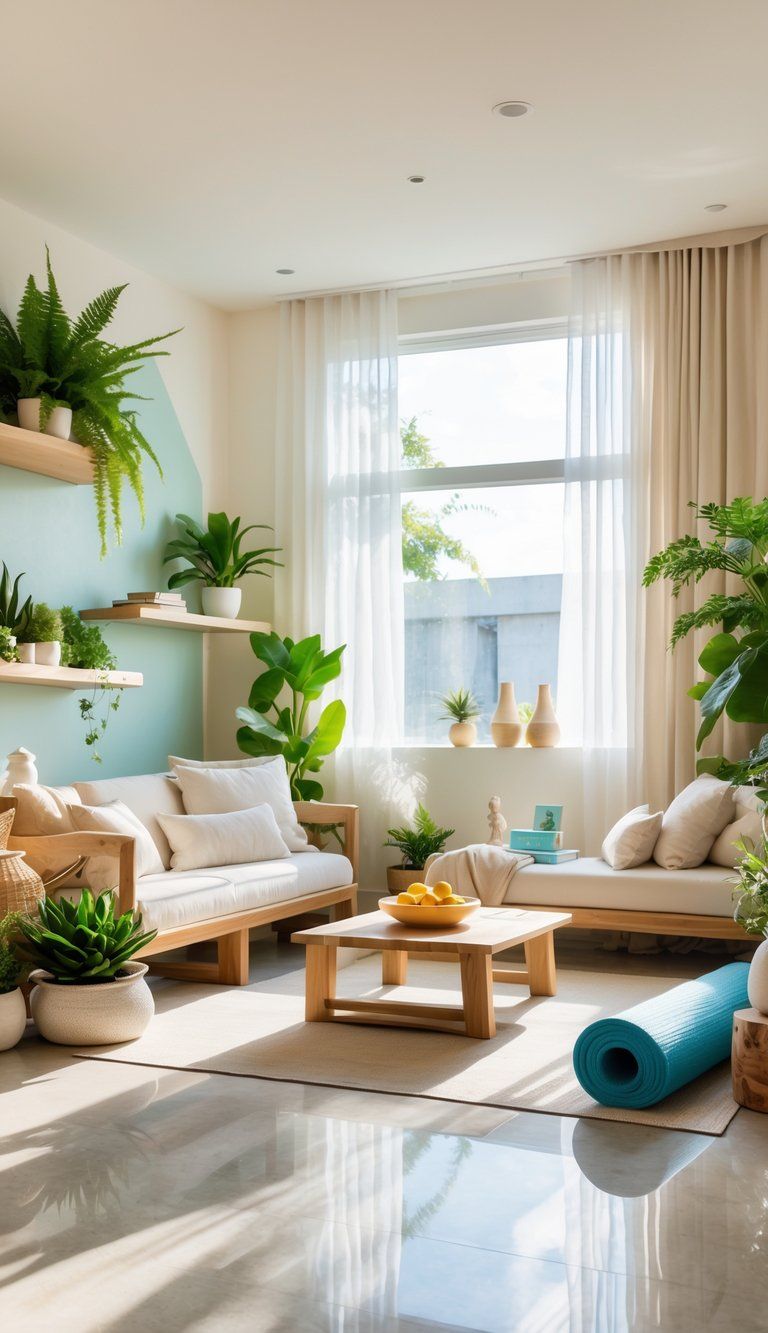
The way you design your home affects how you feel every single day. The right touches can turn your space into a real sanctuary for your body and mind.
Using Natural Light and Nature Indoors
Natural light works wonders for wellness. It keeps your body clock in sync, lifts your mood, and helps your body make vitamin D.
Move your furniture to catch the daylight. Sheer curtains let in light but keep things private.
Want to get more light? Try these tricks:
- Mirrors: Place them across from windows to bounce light around.
- Glass doors or interior windows: Let light move from room to room.
- Skylights or solar tubes: Bring sunlight into dark corners.
If you can, give yourself a view of nature. Even a glimpse of greenery can lower stress and help you focus.
No windows? Hang up some nature photos or artwork for a similar effect.
Selecting Calming Decor and Natural Materials
What you choose for colors and materials really sets the mood. Go for soothing shades—blues, greens, and earthy neutrals help you feel grounded.
Natural materials add warmth and make things feel more real:
- Wood furniture or floors
- Stone countertops or simple accents
- Clay, ceramic, or terracotta pieces
- Textiles like cotton, linen, wool, or jute
Skip filling every surface with decorations. Choose a few things you really love or that serve a purpose.
Soft textures—think plush rugs, pillows, and throws—add comfort and invite you to relax.
Incorporating Indoor Plants and Houseplants
Plants are your wellness buddies. They clean your air and make your place feel alive.
Research shows that indoor plants can lower stress and even speed up healing.
Try these easy starter plants:
- Snake plants: Tough, need little light or water
- Pothos: Fast-growing, hard to kill
- ZZ plants: Super low-maintenance
- Spider plants: Air-purifying and easy to share
Put plants where you hang out the most. Even one per room can make a difference.
Mix up the sizes—tall floor plants, table plants, and hanging ones keep things interesting and help clean the air.
Air Quality and Comfort Essentials
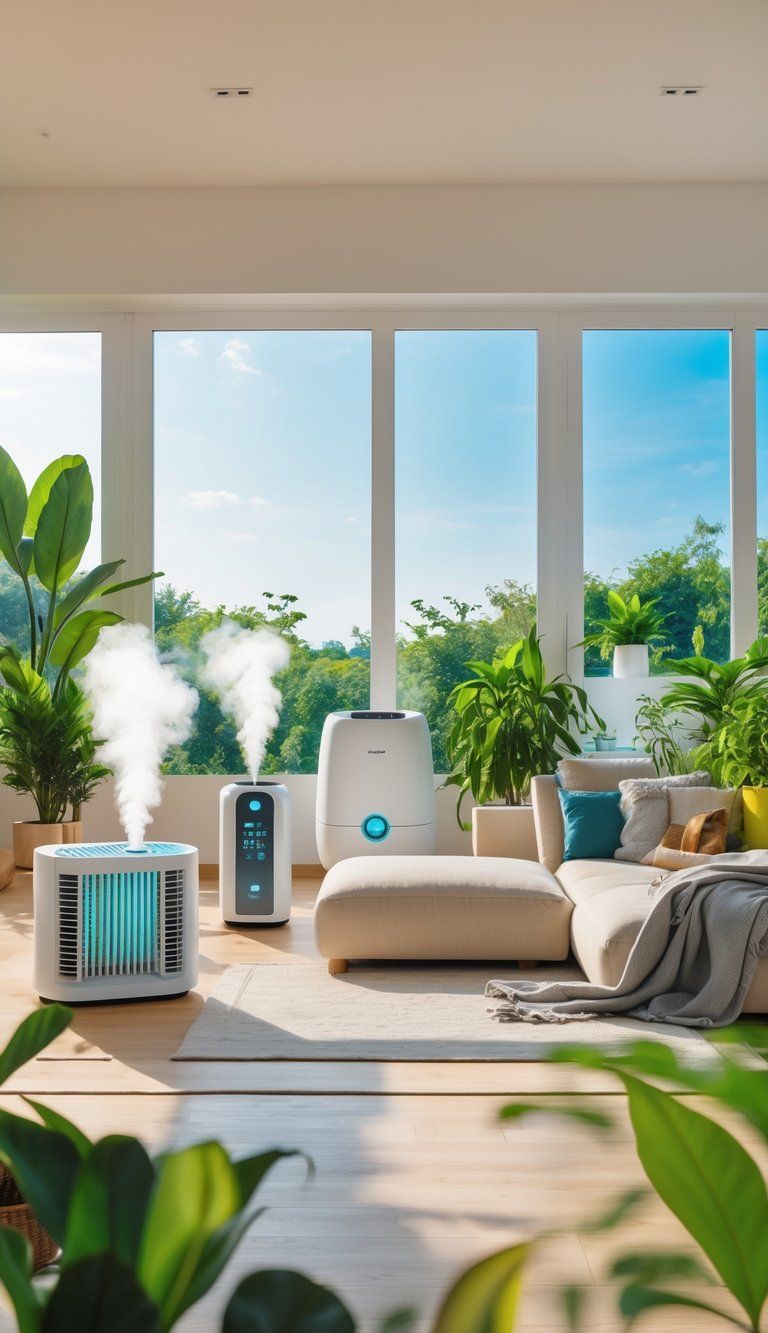
Your home’s environment directly shapes your health. Clean air, comfy furniture, and control over noise and light lay the groundwork for feeling your best.
Improving Air Quality with Air Purifiers and Plants
Indoor air can be up to five times dirtier than outdoor air. That’s not great for your breathing, sleep, or overall health.
Air purifiers with HEPA filters can trap nearly all the dust, pollen, and pet dander floating around.
Pick a purifier that fits your room size. Set it up in the places you spend the most time—usually bedrooms or living rooms.
Plants help too. Spider plants, snake plants, and peace lilies all clean the air and don’t need much fussing over.
Aim for one or two plants per 100 square feet to really notice a difference.
Don’t forget to swap out your HVAC filters every month or so to keep your air fresh.
Choosing Ergonomic Furniture and Quality Bedding
Furniture has a bigger impact on your body than you might think. An ergonomic chair with good lumbar support saves your back during work.
Look for adjustable height and armrests, plus a seat that lets your feet rest flat.
For sofas, pick ones with firm but comfy cushions. You want to be able to sit back with your feet touching the floor.
Good bedding can totally change your sleep. Go for:
- A mattress with medium-firm support
- Pillows that keep your neck in line
- Sheets made from cotton or linen so you don’t overheat
- A comforter that’s the right weight for your climate
Switch out pillows every year or two, and replace mattresses every 7-10 years.
Controlling Noise and Light for Relaxation
Noise and light can really mess with your sleep and stress. Heavy curtains, rugs, and upholstered furniture help soak up sound.
A white noise machine can mask annoying sounds, especially if you live in a noisy area.
Blackout curtains block almost all outside light, which helps you sleep better. During the day, blinds let you adjust how much sunlight comes in.
Smart lights that dim can help your body wind down at night. Set them to warmer, softer tones in the evening to signal it’s time to relax.
Establishing Routines for Healthy Living
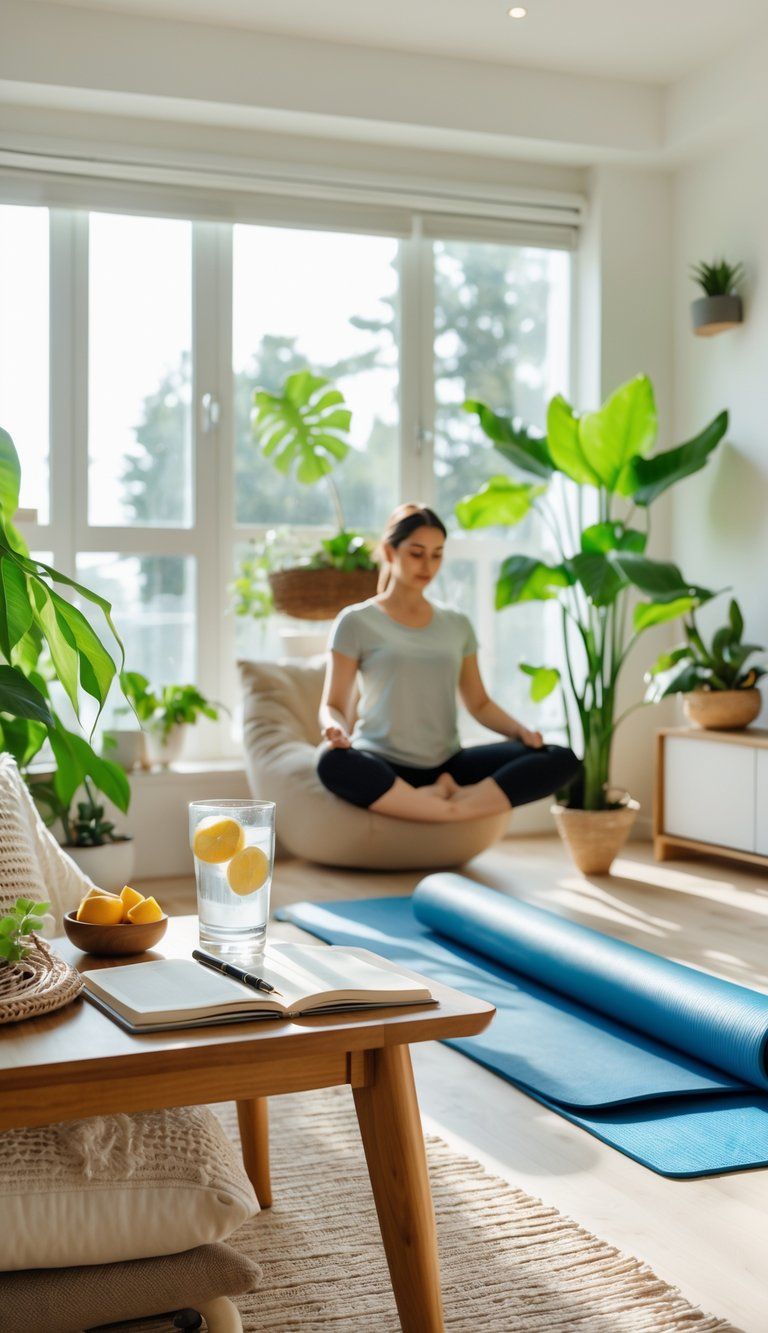
Building healthy habits at home takes regular routines that match your wellness goals. When you set up easy patterns for eating, drinking water, or starting your day, those actions become second nature.
Building Supportive Morning Routines
Kick off your day with intention by shaping a morning routine that actually feels good. Try waking up at the same time each day—even on weekends. It helps your body get into a groove.
Set a glass of water on your nightstand before bed. When you wake up, drink it right away. It’s a tiny thing, but it gets your system moving and helps with hydration.
Spend 5-10 minutes stretching or meditating to gently start the day. If you keep a yoga mat or meditation cushion where you can see it, you’ll remember to use it.
Set up a little morning zone—maybe a comfy chair, your journal, or some light exercise gear. Having your stuff ready makes it way easier to stick to the routine.
Creating Meal Prep and Nutrition Habits
Pick a day, like Sunday afternoon, for meal prep. It sets you up for healthy eating all week. Glass containers help you see what’s ready to grab in the fridge.
Make a “prep station” in your kitchen. Keep cutting boards, sharp knives, and containers handy. When everything’s in reach, you’re less likely to skip healthy cooking.
Stock your pantry with whole foods—beans, brown rice, nuts. Put these at eye level. Hide the junk food up high or somewhere less tempting.
Try this meal prep rhythm:
- Sunday: Cook proteins and roast veggies
- Wednesday: Refresh your stash—cut more veggies or prep salads
Hydration and Healthy Snack Planning
Scatter water bottles or pitchers around your home. Keep one in your office, living room, and bedroom to remind yourself to drink more.
Set up a snack drawer in your fridge with healthy, pre-portioned options. Things like cut veggies, fruit, or yogurt cups make good choices when you’re hungry.
Make a “grab and go” spot near the door. Toss in some nuts, fruit, and water. It’s a lifesaver on busy days and keeps you from buying junk on the run.
Use timers or an app to nudge you to drink water. Some folks like bottles marked with time goals—it’s surprisingly motivating.
Incorporating Physical Activity and Mindfulness
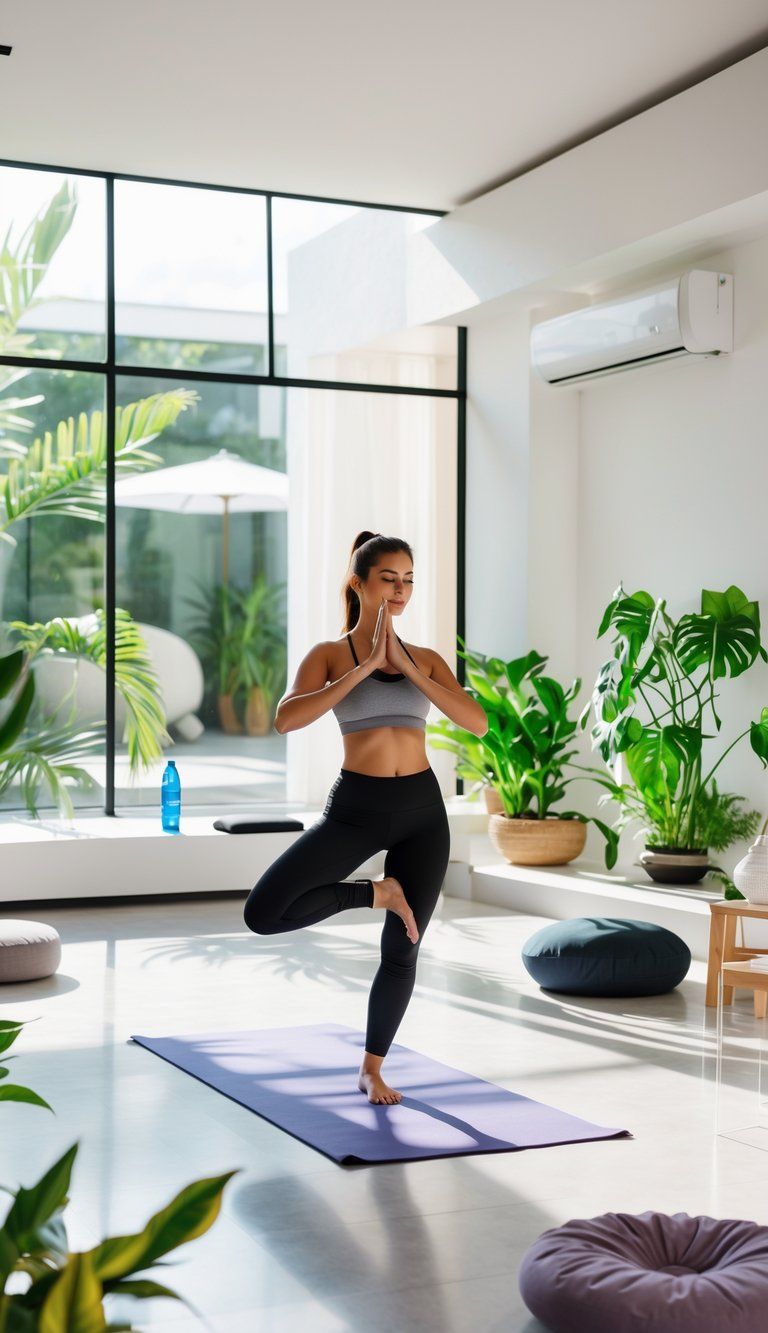
Carving out space for movement and calm at home really sets you up for better wellness. Smart design nudges you to move and gives you moments of peace you might not otherwise take.
Setting Up Spaces for Fitness and Yoga
You don’t need a fancy gym. Even a 6×8 foot patch of clear floor works for yoga or bodyweight moves. If you can, pick a spot with sunlight and fresh air.
Keep your gear out where you’ll see it, but not messy. Shelves or baskets hold mats, bands, and small weights within arm’s reach.
Think about the floor. A thick mat is fine on carpet, but if you’ve got hard floors, those puzzle-piece foam tiles are a game changer.
A mirror helps you check your form and makes the area feel bigger. Just one full-length mirror can really open up the space.
Integrating Mindfulness Practices into the Home
Set up a mindfulness corner with a cozy cushion or chair. When you sit there, your brain gets the hint—it’s time to slow down. Don’t overthink it; a candle, plant, or little table is enough.
Sound plays a big role in calm. Notice how noise travels in your home. White noise machines, soft music, or even a little fountain can help block out distractions.
Morning light helps your body clock. Put your meditation spot near an east-facing window if you can, and use sheer curtains to soften the light.
Set up device charging stations away from your relaxation zone. It’s a small tweak, but it really cuts down on the urge to check your phone and helps you stay present.
Emotional and Mental Well-Being

Your home should feel like a safe haven for your mind and emotions. Spaces that encourage calm and positive thinking can have a bigger impact than you might expect.
Creating Spaces for Relaxation and Reflection
Pick a quiet corner just for relaxing. Maybe it’s a chair by a sunny window, a window seat, or even a soft spot in your bedroom.
Add things that help you unwind. Think soft pillows, a blanket, or a spot for tea. Try to keep electronics out of this area.
Bring in items that make you feel peaceful—maybe a small fountain, some air-purifying plants, or even a meditation cushion. Even tiny touches can turn a corner into a reflection spot.
Make this space your own. Add things that make you smile or feel at ease.
Fostering Positivity and Gratitude
Surround yourself with reminders of good times and people you love. Family photos, travel keepsakes, or art that brings back happy memories can shift your mood.
Set up a gratitude wall or corner. Jot down things you’re thankful for and post them up. On tough days, seeing those reminders can really help.
Pick colors that lift your spirits. Blues and greens usually calm things down, while yellow is energizing. Paint a wall or add a few colorful pillows—whatever feels right.
Scents change the vibe too. Lavender’s relaxing, citrus wakes you up, and cinnamon just feels cozy. Try an oil diffuser or a candle to switch up the mood.
Supporting Emotional Wellness Through Design
Cut down on clutter—it’s surprisingly stressful. Use storage that hides the mess and make a habit of clearing out what you don’t need.
Mix open areas with cozy nooks. Sometimes you want space to breathe, and sometimes you need a snug spot to feel safe.
Choose lighting that matches your mood. Overhead lights can be harsh, but lamps and dimmers let you set the tone. Layer your lighting for more options.
Bring in natural touches like wood, stone, or plants. Even a little bit of nature indoors can help you focus and feel less stressed.
Keep work and chill zones separate, especially if you work from home. It helps your brain switch gears.
Sensory Elements and Enhancements
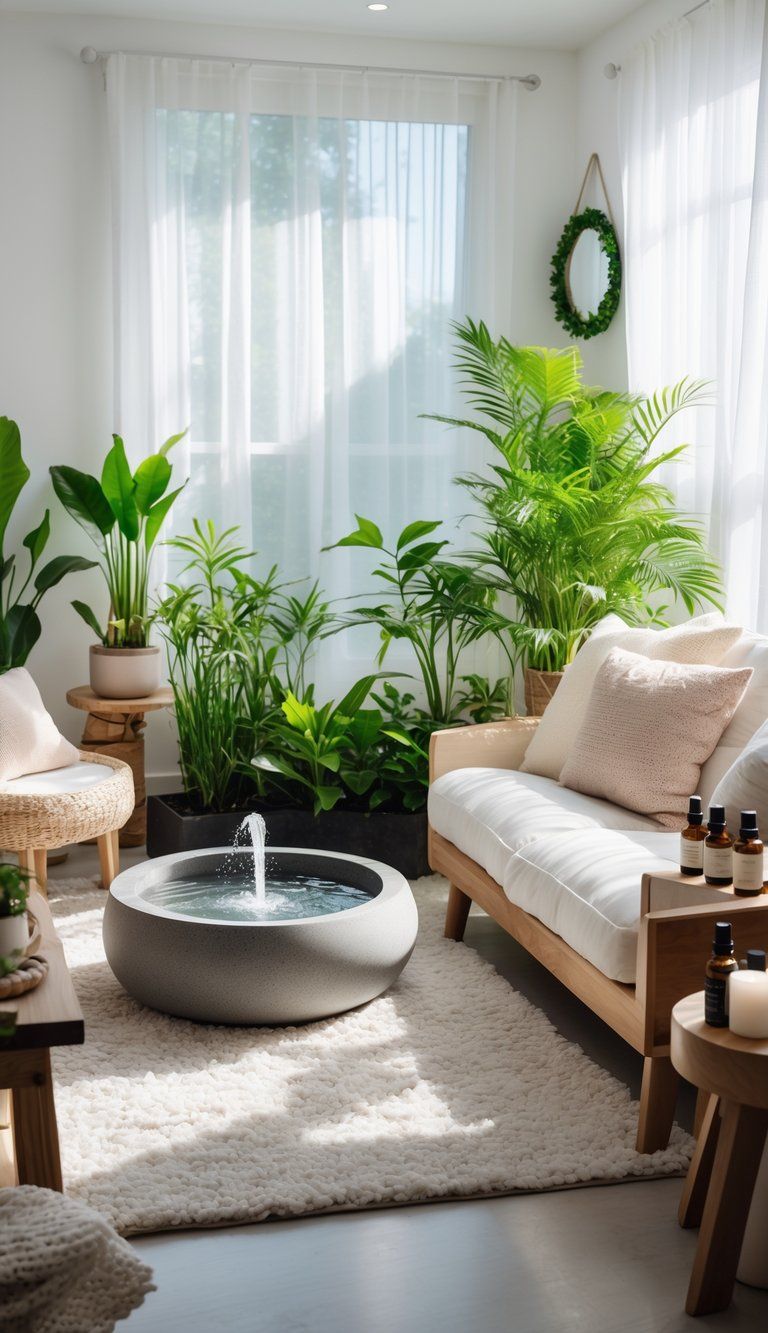
A home that appeals to your senses can really boost your overall well-being. The right scents and lighting can turn a basic room into a space you actually want to be in.
Aromatherapy and Scents for Well-Being
Aromatherapy’s an easy way to make your home feel better. Lavender calms you down, citrus perks you up—it’s kind of amazing how much scent can shift your mood.
Try these options:
- Diffusers: Electric or reed diffusers fill the room with scent
- Scented candles: Smell good and add a cozy glow
- Linen sprays: Spritz your bedding for better sleep
Mix your own blends if you’re feeling creative. Eucalyptus and lavender chill you out, while peppermint and orange are great for work or workouts.
Optimizing Light with Blackout Curtains
Lighting really affects how you feel and sleep. Blackout curtains block out light for better rest.
Here’s why blackout curtains help:
- They make your room pitch dark, which helps you sleep better
- They block outside noise (up to 40%, apparently)
- They keep your place warmer in winter and cooler in summer
You can find blackout curtains in all sorts of styles, so they don’t have to look boring. Hang them in bedrooms or meditation spots where you want to control the light.
Pair blackout curtains with soft, adjustable lamps or string lights. That way, you can set the mood however you like.
Hygiene and Adaptability in the Home
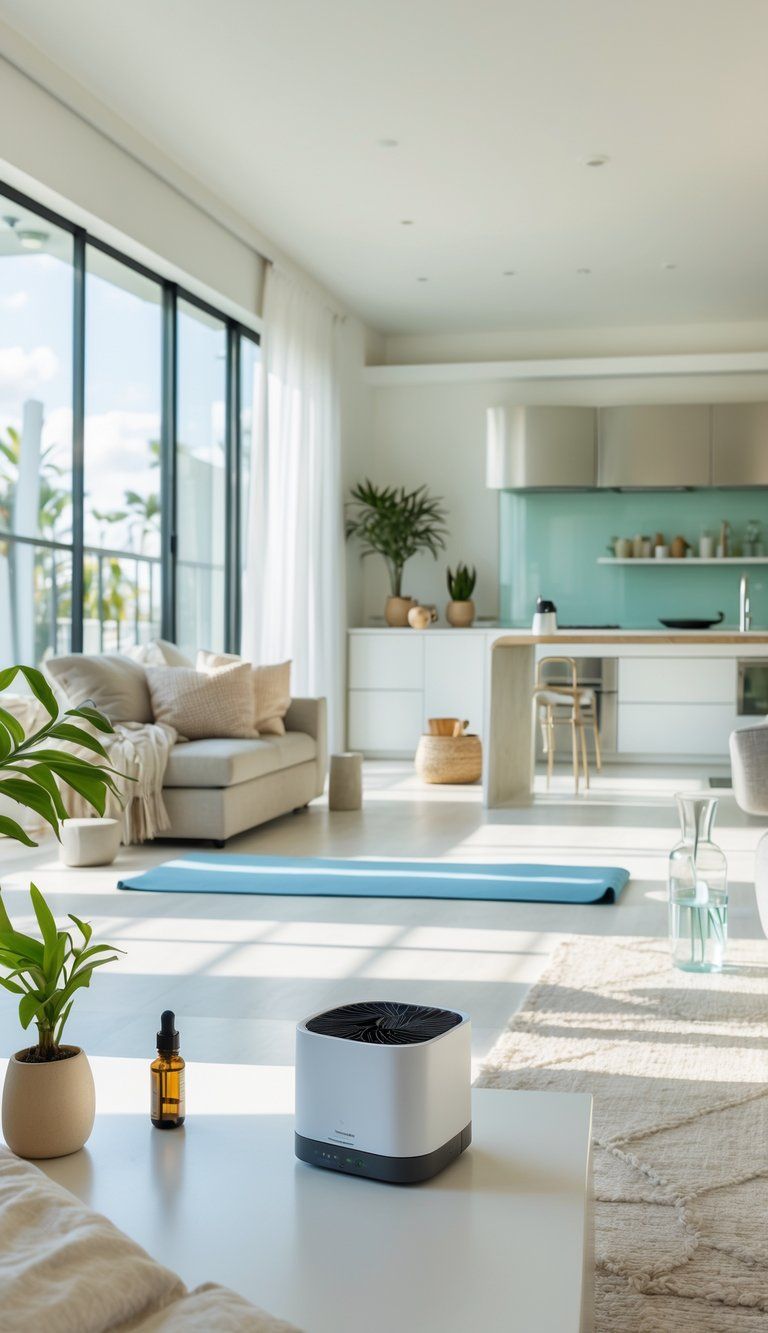
Your home environment really affects your wellness. Keeping things clean and being able to change things up as your needs shift can make a big difference.
Maintaining Cleanliness and Hygiene
A clean home just feels better. Cleaning regularly keeps dust and germs in check. Set up a simple routine that fits your life.
Try natural cleaners like vinegar, baking soda, and lemon. They’re effective and don’t mess with your air quality.
Set up “clean zones” in busy spots like entryways. Put a shoe rack and hand sanitizer by the door to keep outside stuff from spreading through your home.
Air quality matters, too. Open the windows for fresh air when you can. If your area has pollution, grab an air purifier with a HEPA filter.
Adapting Your Space to Evolving Wellness Goals
Wellness needs rarely stay the same for long, so your home should flex right along with them. I always recommend choosing furniture that does more than one thing—it just makes life easier as your priorities change.
You can move lightweight pieces around and quickly turn a dining area into a mini gym. If you go for furniture that’s easy to shift, you’ll never feel stuck with one setup.
Built-in storage keeps things tidy, especially as you swap out wellness gear over time. Adjustable shelves can expand or shrink to fit whatever you need right now.
Try mixing in modular details that you can swap out without tearing up the whole room. Stuff like peel-and-stick wallpaper, area rugs, or a new piece of art helps you change the vibe fast when your wellness goals take a new direction.

